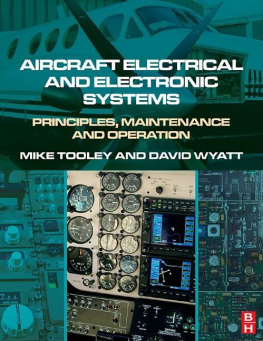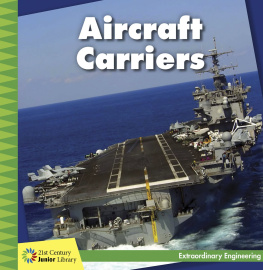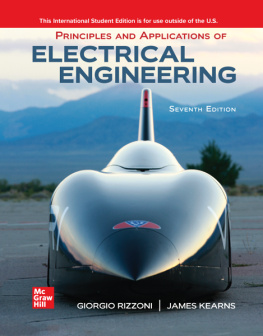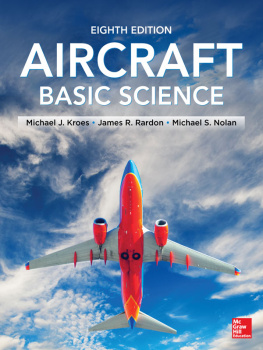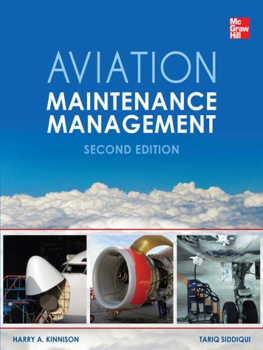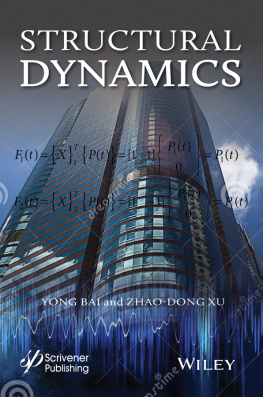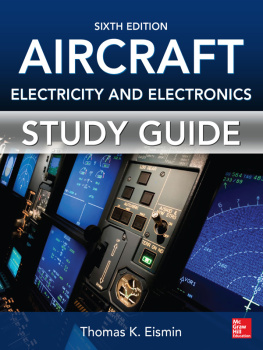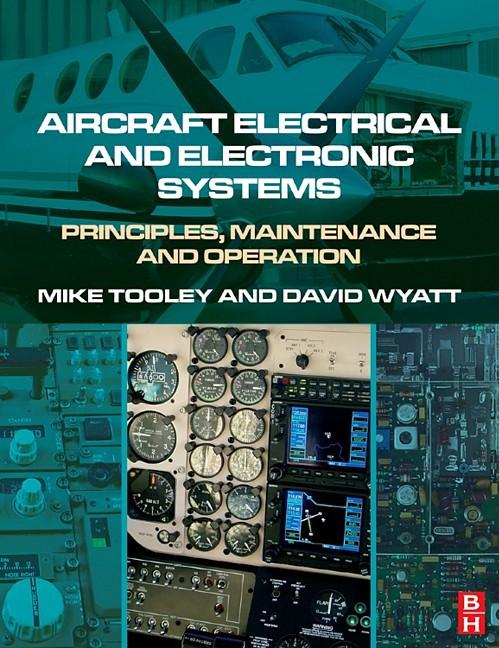Aircraft Electrical and Electronic Systems
Principles, operation and maintenance
Mike Tooley
David Wyatt
Brief Table of Contents
Table of Contents
Copyright Page
Linacre House, Jordan Hill, Oxford OX2 8DP, UK
30 Corporate Drive, Suite 400, Burlington, MA 01803, USA
The right of Mike Tooley and David Wyatt to be identifi ed as the authors of this work has been asserted in accordance with the Copyright, Designs and Patents Act 1988
No part of this publication may be reproduced, stored in a retrieval system or transmitted in any form or by any means electronic, mechanical, photocopying, recording or otherwise without the prior written permission of the publisher
, and selecting Obtaining permission to use Elsevier material
NOTICE
No responsibility is assumed by the publisher for any injury and/or damage to persons or property as a matter of products liability, negligence or otherwise, or from any use or operation of any methods, products, instructions or ideas contained in the material herein.
Disclaimer
This book draws on many sources. Some are facts, some hypotheses, some opinions. Most including many of my own statements are mixtures. Even 'facts' are unavoidably selective and can rarely be guaranteed. Despite careful checking, neither I nor my colleagues or publishers can accept responsibility for any errors, misinformation or unsuitable advice. This also applies to opinions particularly on issues affecting health and safety. As any recommendations must balance complex, often opposing, factors, not everyone will reach the same conclusions. In thisas indeed in every issue this book touches on every reader must make up her or his mind, for which they alone must be responsible.
I offer the best advice I am capable of, but every circumstance is different. Anyone who acts on this advice must make their own evaluation, and adapt it to their particular circumstances.
British Library Cataloguing in Publication Data
A catalogue record for this book is available from the British Library
Library of Congress Cataloging-in-Publication Data
A catalog record for this book is available from the Library of Congress
ISBN: 978-0-7506-8695-2
For information on all Butterworth-Heinemann publicationsvisit our website at www.Elsevierdirect.com
Printed and bound in Great Britain
09 10 11 12 13 10 9 8 7 6 5 4 3 2 1
Preface
Aircraft Electrical and Electronic Systems continues the series of textbooks written for aircraft engineering students. This book addresses the electrical contents of the EASA Part 66 Modules 11 and 13; it also provides reference material for the avionic and aircraft electrical units of various BTEC National and Higher National, City and Guilds, NVQ and Foundation Degree modules.
This book is designed to cover the essential knowledge base required by certifying mechanics, technicians and engineers engaged in engineering maintenance activities on commercial aircraft and in general aviation. In addition, this book should appeal to members of the armed forces and others attending training and educational establishments engaged in aircraft maintenance and related aeronautical engineering programmes. This book will also appeal to others within the aircraft industry who need an insight into electrical and electronic systems, e.g. pilots, engineering managers, etc.
The book provides an introduction to the fundamentals of electrical, electronic and digital theory that underpins the principles of systems covered in the remainder of the book. For the reader that already has background knowledge of the fundamentals, the subsequent chapters can be read as individual subjects. For the reader that requires a deeper understanding of related fundamentals, additional material can be found in related books in the series:
- Aircraft Engineering Principles
- Aircraft Digital Electronic and Computer Systems
- Aircraft Communications and Navigation Systems.
The books in this series have been designed for both independent and tutor-assisted studies. They are particularly useful to the self-starter and to those wishing to update or upgrade their aircraft maintenance licence. The series also provides a useful source of reference for those taking ab initio training programmes in EASA Part 147 and FAR 147 approved organizations as well as those following related programmes in further and higher education institutions.
The title of this book, Aircraft Electrical and Electronic Systems, has been specifically chosen to differentiate between other avionic systems such as communications, navigation, flight guidance and instruments. The term avionics (aviation electronics) was first used in the late 1940s to identify electrical and electronic equipment such as radar, radio navigation and communications, although the term was not in general use until the late 1960s. During the 1970s, integrated computer-based systems were being developed, e.g. ground proximity warning systems; these used a number of existing aircraft sensors that monitored parameters such as barometric altitude, vertical speed and radio altitude.
The continued development and integration of electrical and electronic systems, together with the widespread use of integrated circuits, microprocessors, data communications and electronic displays, have given new meaning to the term avionics. Aircraft engineers will be exposed to in-service aircraft using older technology, together with the new aircraft entering service based on modern technology. Using trends from the last 40 years, there will be an ever-increasing dependence on avionic systems. The eventual outcome could be the all-electric aircraft, a concept where traditional mechanical linkages, hydraulics and pneumatics are totally replaced by electrical and electronic systems.
This book establishes a reference point for engineering students; it does not attempt to address all system types for all aircraft types. It is also important to note that this book does not attempt to provide the level of detail found in the aircraft publications, including the maintenance and wiring diagram manuals. Although there are many examples quoted in the book that are based on specific aircraft types, this is only done to illustrate a specific point.
Throughout the book, the principles and operation of systems are summarized by numerous key points. The reader will be invited at regular intervals to assess knowledge via test your understanding questions. Finally, the principles and operation of systems are put into the context of aircraft maintenance engineering by numerous key maintenance points. Each chapter concludes with a number of multiple choice questions; the reader will then find revision papers in the appendices for additional assessment purposes. A summary of the book is as follows.
sets the scene by providing an explanation of electricity in terms of the motion of electric charge and basic electrical quantities such as current, voltage, resistance and power. The chapter provides an introduction to electrostatics and capacitors and also to electromagnetism and inductors. Here the emphasis is on the key concepts and fundamental laws that underpin the operation of the electrical systems found in aircraft. The chapter provides a detailed introduction to alternating current and transformer principles, and concludes with an essential section on safety. This chapter will be particularly useful if you have not previously studied electrical principles. It has also been designed to help fill any gaps in your knowledge and bring you quickly up to speed.

